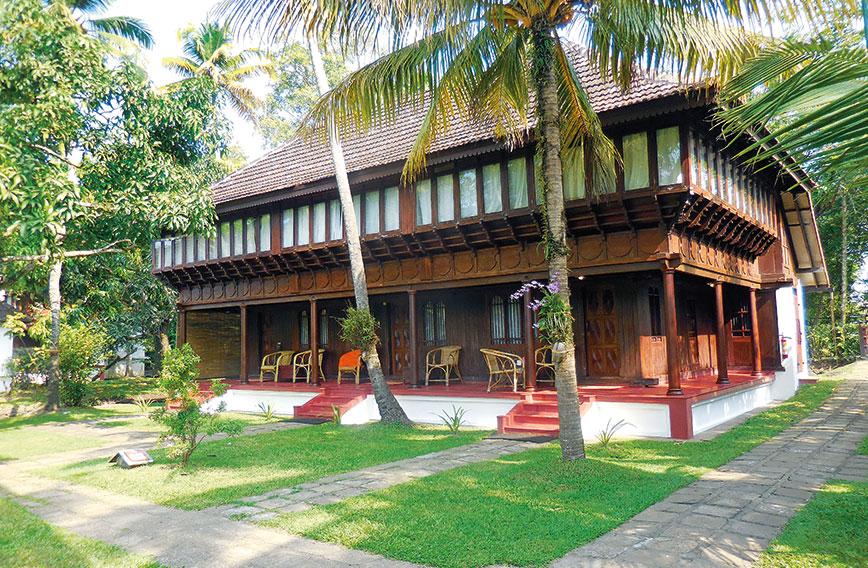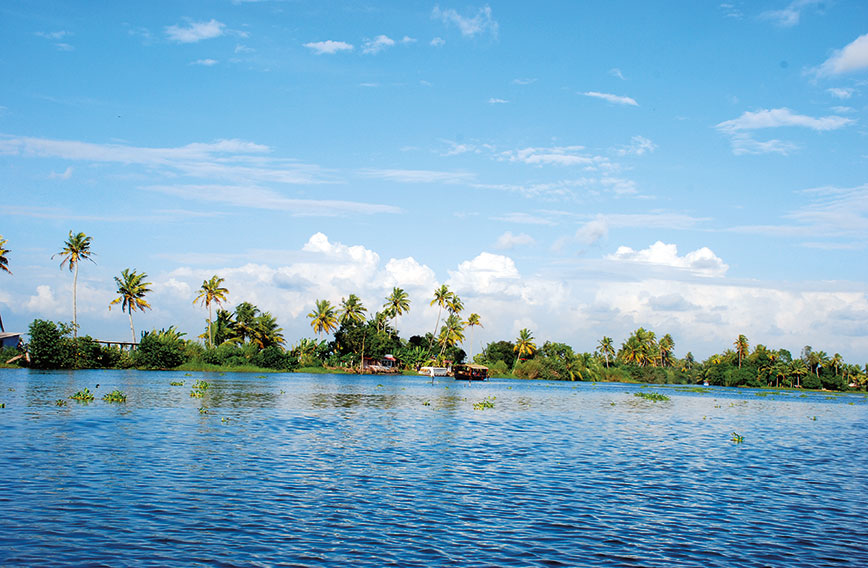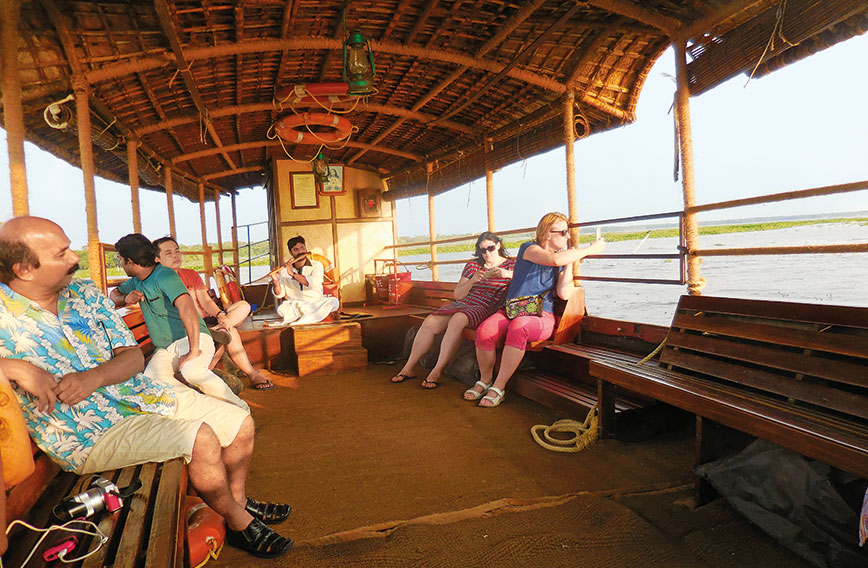
An elegant traditional cottage | Photgraphy by Susheela Nair
Coconut Lagoon brings back the original Kerala tharavad
Susheela Nair, Thiruvananthapuram
From the private jetty the boat chugged across the Vembanad lake, the largest wetland ecosystem in Kerala. Serene hamlets nestled amidst swaying groves of coconut palms and green stretches of paddy fields set the tone of our relaxed holiday. There was a sense of tranquility from the moment we entered this charming idyll. The site is criss-crossed with canals which are an extension of the topography of the backwaters. Small bridges got us across the separated land masses.
Set in Kumarakom, in the midst of the backwaters and the never ending Vembanad lake, Coconut Lagoon is a tile and timber mansion — a typical traditional Kerala tharavad painstakingly transplanted and restored. The most striking feature of the resort is its architectural elegance, the structures having been built from old houses that were abandoned or destined to be razed. These have been carefully dismantled and relocated to this property from surrounding villages and then reassembled, beam by beam, by descendants of the master craftsmen who originally built them. By using local building materials, the use of cement, tiles and steel was drastically reduced.
 The picturesque Vembanad lake | Photograph by Susheela Nair
The picturesque Vembanad lake | Photograph by Susheela Nair
We stepped out of the boat into the reception area, housed in a traditional naalukettu. There are heritage mansions, bungalows and pool villas, surrounded by the captivating sight of the Kumarakom backwaters and vistas of natural expanses — a haven for birdlife. We were ushered into our guest cottages with the rustic flavour of classic Kerala styling laced with modern comforts. The centrally located restaurant is said to be the oldest structure in the resort. It is housed in an ettukettu — a structure with two atriums, similar to courtyards, under a roof supported by pillars.
The resort was built without disturbing any of its original topography. All the old trees including mangroves were preserved. More saplings were planted, adding to local biodiversity. The canals, thanks to a profusion of fish, do not breed mosquitoes. And, unlike mosquitoes that breed in stagnant water, there are dragonflies here which perch and thrive in fresh water. The dragonfly is an indicator of the health of an ecosystem.
Coconut Lagoon is quite a birdwatcher’s paradise with more than 60 different species. There are esteemed visitors like the southern birdwing, the largest Indian butterfly. The organic paddy fields and adjoining fallow lands have seen an increase of bird population, enough to merit a couple of birdwatching perches. The fact that we could see about 30 different species of birds in an hour is quite impressive by birdwatching standards.
 Enjoy a sunset cruise on the Vembanad lake | Photograph by Susheela Nair
Enjoy a sunset cruise on the Vembanad lake | Photograph by Susheela Nair
Responsible tourism: Coconut Lagoon is part of the CGH Earth Group’s chain of hotels. “Responsible tourism is an integral part of our DNA. CGH Earth has pursued eco preservation with a passion – worm farms, solar panels, recycling and rainwater harvesting are mandatory features at almost all our properties. The results have been rewarding. One clear cause and effect situation is the butterfly garden, where our efforts have been rewarded with beauty or in the dragonfly population, which can thrive only in a clean aquatic environment where they can lay eggs,” says Jose Dominic, managing director of CGH Earth Hotels.
A CGH holiday offers a beautiful, relaxing destination with an unspoiled feel of the local environment. “We are uncompromising about promoting responsible tourism and there are no two ways about it. We are not about luxury holidays. We want to provide engaging experiences that benefit not only the traveller but also the local community, with minimal disturbance to the local environment,” explains Dominic.
“In the 1990s, CGH Earth introduced a model of innovation, creating products which were small and local. It became successful in a very short time. The business was built on our core philosophies of including the local community, minimising the impact on the environment, giving local experiences and creating value proposition for the customer,” added Dominic.
Green initiatives: The resort does not discharge any waste from its boats into the lake and they work with local governing bodies to educate and spread the message of good environmental practices. We observed that great emphasis is laid on material and waste reduction. Suppliers are encouraged to deliver their products in recycled containers instead of plastic packaging. Packaged water in plastic bottles has become a grave environmental issue for the hospitality industry. To reduce the burden of waste, CGH Earth bottles and serves purified rainwater in glass bottles that can be reused. Some of the dry waste is used in truly creative ways.
Rainwater harvesting and waste management is built into their management systems. Food and animal waste processed at the biogas plant fuels the staff kitchens. Water from baths and the Ayurveda centre is processed for human consumption. Wet waste is turned into biogas and vermicompost which are used as cooking fuel and manure, respectively.
There is never a dull moment at the resort. We tried the freshly brewed tea from the floating tea stall gliding in the canal. It tries to capture the romance of the period with tea served out of old-style copper samovars. We set out on a nature trail and enjoyed the birds and butterflies that thrive by the Vembanad lake. We explored life in the backwaters; visited the bird sanctuary and farms, and learnt to cook with spices. Relaxing in our verandah, we were transported to a world of peace and contentment. We watched the endangered vechoor cows graze and ‘mow’ the endless lawns. The refreshing greenery, the bird calls, the omnipresent butterflies all indicate a clean, green and healthy atmosphere and you know all is well with the world.
FACT FILE
Getting there: Coconut Lagoon is a 10-minute boat ride from the jetty, which is 10 km from Kottayam.
Nearest airport: Kochi (74 km). The nearest railhead is Kottayam.
Address: Kumarakom, Kottayam District,
Kerala – 686 563
Tel: 91 481 2528200 / 0484 426171
Email: [email protected]; [email protected]
Comments
Currently there are no Comments. Be first to write a comment!



